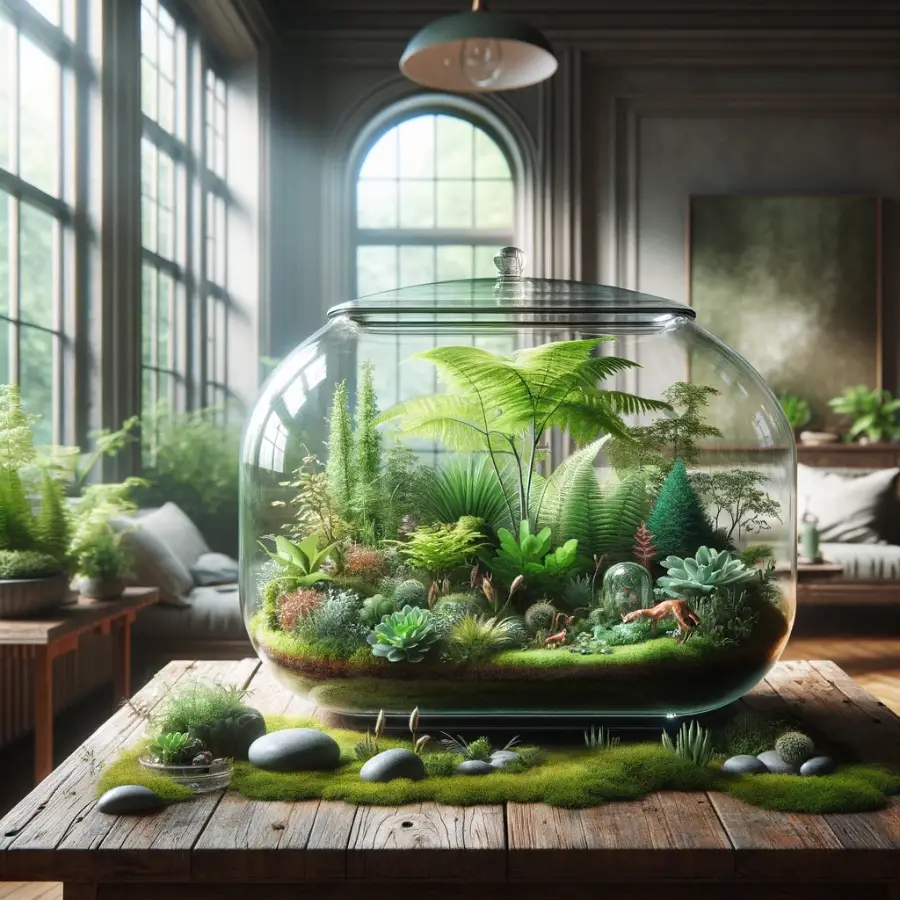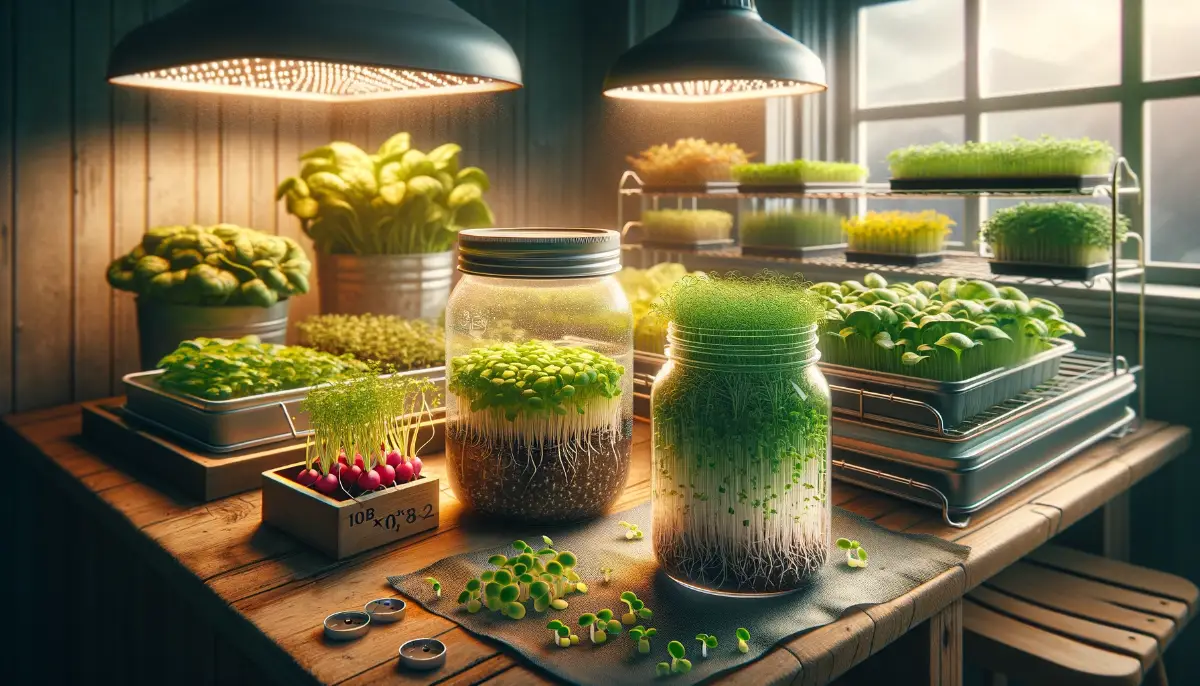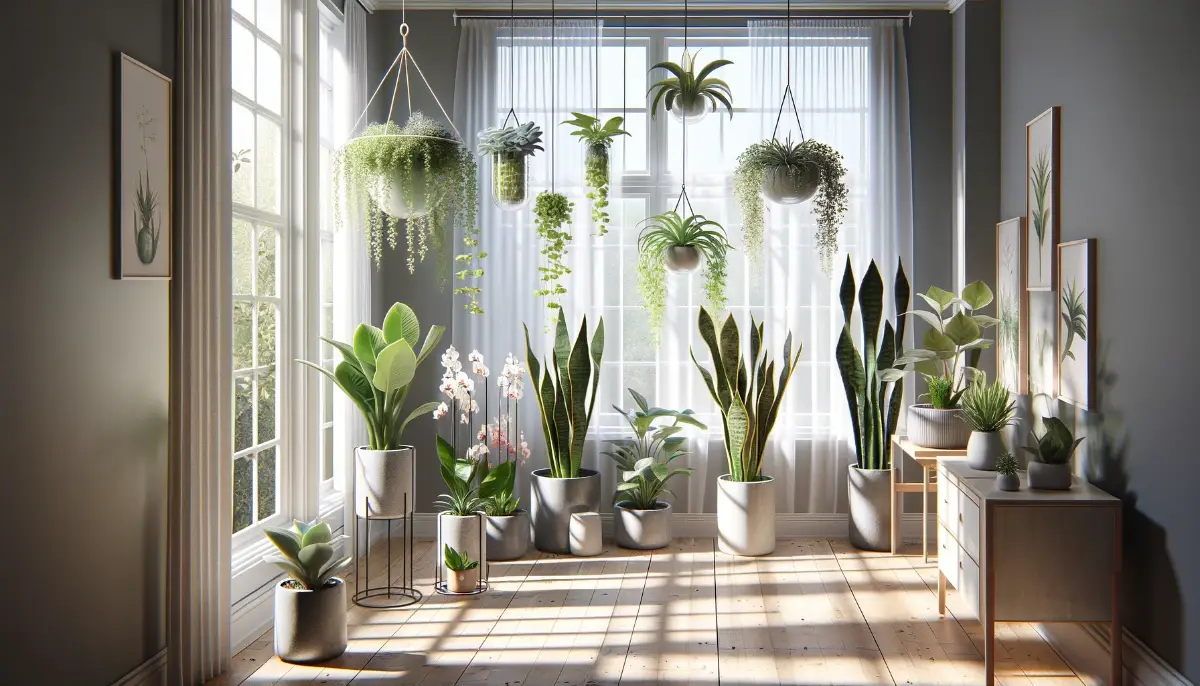Terrariums bring the serenity of nature into your living space, encapsulating a miniature landscape within a glass container. Whether you’re a seasoned green thumb or new to the gardening world, this guide will walk you through creating your own indoor plant terrarium, transforming any room into a verdant sanctuary.
- Learn the basics of terrarium crafting.
- Understand the differences between open and closed terrariums.
- Discover the best plants for your terrarium.
- Master the art of terrarium layering for optimal plant health.
How to Make and Maintain Plant Terrariums
Choose Your Container
Choosing the right size for your terrarium involves considering the space available, the types of plants you want to include, and your capacity for maintenance. Here are some general guidelines and examples to help you decide:
Types of Large Terrariums:
- Bottles: Large bottles, such as carboys or demijohns, can house tropical terrarium plants and are a classic choice. They can be over 50 liters in volume but require skill to plant due to the narrow opening.
- Wardian Cases: These are elegant, large glass containers that can accommodate taller plants needing headroom. They resemble miniature greenhouses and are great for a large terrarium setup.
- Tanks: Including both horizontal and vertical types, tanks offer versatility and the ability to incorporate modern technical systems like lighting and ventilation. They’re suitable for ambitious landscapes and can be custom-designed to fit your vision.
Choosing Based on Shape and Opening:
- Containers with a uniform shape, like a box or cylinder, provide a consistent environment for plant growth. The shape of the container can impact drainage and the amount of substrate available for plants.
The size of the terrarium’s opening is also crucial. A narrow opening may present challenges for planting and maintenance, whereas a wide opening allows easier access for planting and care.
Container Lid:
- If you opt for a closed terrarium, ensuring you have a way to seal it is essential. While some terrarium containers come with a lid, you can also get creative with makeshift lids from materials like perspex discs or cork stoppers.
Material Considerations:
- Glass is the preferred material for terrariums due to its durability, non-reactive nature, and clarity, allowing for optimal light transmission for photosynthesis.
When deciding on the size of your terrarium, consider the growth potential of the plants you wish to include. For a terrarium accommodating three 2″ plants, a container with a 6″ width or diameter is typical. If you’re aiming for larger or more numerous plants, a larger container will be necessary. Smaller containers suit smaller plants with defined foliage.
Create a Drainage Layer to Plant Terrariums
Start by adding a layer of small stones, gravel, or pebbles at the bottom of your container. This layer ensures excess water can drain away from the plant roots, preventing root rot.
Add a Substrate Barrier (Optional)
To keep the soil from mixing into the drainage layer, consider adding a thin barrier such as a shade cloth or screen mesh. This is especially helpful if your container is deep or has a wide opening.
Incorporate Activated Charcoal
A layer of activated charcoal atop the drainage layer or mixed with the soil can help reduce bacteria, fungi, and odors, creating a healthier environment for your terrarium plants.
Add Soil to Your Terrarium
Choose a high-quality soil mix that’s appropriate for the types of plants you’re including. A mix containing coco coir, horticultural charcoal, worm castings, and orchid bark is ideal for most terrarium plants, providing the necessary drainage, moisture retention, and nutrients.
Plant Your Terrarium
For creating a thriving terrarium, selecting the right plants is crucial. The best plants for terrariums are those that can thrive in the humid, contained environment of a terrarium. Here’s a diverse selection that includes both aesthetic appeal and easy care:
Maidenhair Fern (Adiantum raddianum) – Ideal for taller terrariums, loves moisture, and adds delicate texture with its densely packed thin green leaves.
String of Hearts (Ceropegia woodii) – With tiny heart-shaped leaves, it’s suitable for open terrariums and prefers well-draining substrates.
Baby’s Tears (Soleirolia soleirolii) – Known for creating a lush green carpet, requiring consistent moisture and bright indirect light.
Aluminum Plant (Pilea cadierei) – Offers eye-catching silver-striped foliage, thriving in bright indirect sunlight and making a great centerpiece in large terrariums.
Friendship Plant (Pilea involucrata) – Features textured leaves with burgundy and silver streaks, adding character and life to any terrarium.
Nerve Plants (Fittonia) – Characterized by their vividly contrasting veins, these plants love water and humidity, perfect for a drama-free terrarium life.
Creeping Fig (Ficus pumila) – An easy terrarium plant that grows quickly, filling the space with green leaves. It can be simply dropped into the container to start growing.
Peperomia Varieties – A diverse genus that thrives in indirect light and humid conditions, offering a range of appearances from vines to lush foliage.
Selaginella (Spikemoss) – Resembles mosses and ferns, creates a thick mat, and adds a unique texture and color variation to the terrarium.
Polka Dot Plant (Hypoestes phyllostachya) – Known for its vibrant color and easy care in warm, moist environments.
Moss – Virtually maintenance-free in a terrarium, it keeps the environment vibrant and green with minimal effort.
Add Hardscape Elements
Rocks, branches, or decorative items can add structure, texture, and visual interest to your terrarium. These elements should be placed strategically to complement the plants without overshadowing them.
Moss and Decoration
Moss can be used as a mulch to retain soil moisture and add a finished look. Additionally, consider adding decorative elements like figurines or stones to personalize your terrarium.
Water and Seal
Initially, water your terrarium lightly to settle the plants and soil, ensuring the soil is moist but not waterlogged. If your terrarium is sealed, place the lid on top. For open terrariums, watering will be more frequent but minimal.
How to Water Organic Indoor Plants: The Ultimate Guide
Terrarium Care
Place your terrarium in a location with indirect light. Monitor the moisture levels and water sparingly, as the enclosed nature of terrariums means they require less watering than regular houseplants. Trim any overgrown plants to maintain the structure and health of your terrarium.
FAQs for Plant Terrarium
What plants are best for terrariums?
Choose plants that thrive in high humidity and low light, such as ferns, mosses, and some tropical plants like the nerve plant or small peperomias.
How often should I water my terrarium?
Closed terrariums rarely need watering, perhaps once every 4-6 months. Open terrariums require more frequent watering, depending on the plant types and environment.
Do terrariums need sunlight?
They need indirect light, not direct sunlight, which can cause overheating and burn plants.
Can succulents be used in terrariums?
Yes, but they’re best for open terrariums with dry conditions, not closed, humid ones.
Why is there condensation in my terrarium?
Condensation is normal in closed terrariums and indicates a healthy water cycle but should not cover the glass completely all the time.
How do I prevent mold in my terrarium?
Ensure adequate ventilation, avoid overwatering, and include a layer of activated charcoal to reduce moisture and toxins.
Can I use tap water for my terrarium?
It’s better to use distilled or rainwater to avoid mineral deposits on the glass and potential harm to sensitive plants.
What is a false bottom in a terrarium?
A false bottom is a drainage layer made of gravel, stones, or other materials to prevent waterlogging by keeping excess water away from plant roots.
How do I choose a container for my terrarium?
Select a clear, glass container with a wide opening for easy access and maintenance. The size depends on the number and size of plants you want to include.
Can terrariums help purify the air?
While they contribute to air purity on a small scale, the primary benefit of terrariums is aesthetic and for personal enjoyment rather than significant air purification.









